Jemez Mountains Railroads, Santa Fe National Forest, New Mexico
|

|
Appendix B
PHOTOGRAPHS
These additional figures include more views of
the railroads and other aspects of logging on the Santa Fe National
Forest. The hunt for historic photographs to use in this book was
particularly fruitful. Private collectors have been very generous in
sharing with the author and there are probably many more views in
private hands and unknown to the author or the Forest Service. This
created the happy problem of providing more good pictures than could be
integrated with the text. Also, the costs of publication prevent us from
being able to include every known photograph related to these railroad
operations. In this Appendix we present some views of the people and
facilities at O'Neil Landing which include much information that will be
appreciated both by historians and archeologists. Those are followed by
pictures of additional logging equipment and of several "speeders" used
in the Jemez Mountains.
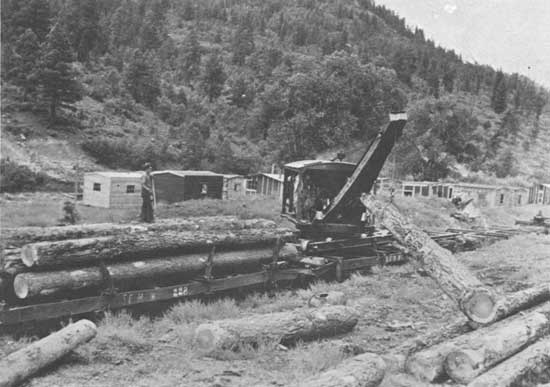
|
|
Figure 68. An American Hoist and Derrick diesel loader working at O'Neil
Landing in the summer of 1939. The logs, of apparent 32-foot length, are
being loaded on SFNW steel log cars. Typical portable living quarters
may be seen beyond the cars. Once the local harvest was complete, these
buildings could be hoisted aboard flat cars and taken to a new location.
This portability is significant to archeologists who later find only a
few foundation stones where once many men lived. (Photo by Yale
Weinstein)
|
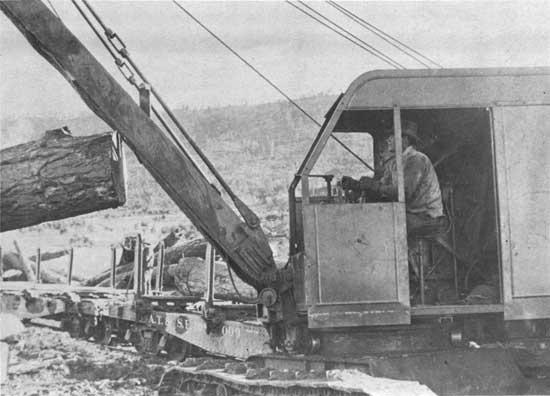
|
|
Figure 69. Pawling and Harnischfeger (P&H) tracked loader working at
O'Neil Landing circa 1937 - 1939. The rail cars are AT&SF Class Lg-1
logging flat cars equipped with four bunks for carrying logs ranging
from about 12 to 36 feet in length. (Photo by Yale Weinstein)
|
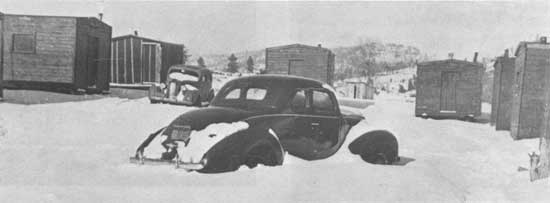
|
|
Figure 70. Bachelor quarters at O'Neil Landing during the winter
shutdown, circa 1939. It looks as if the roads were closed. (Photo by Yale
Weinstein)
|
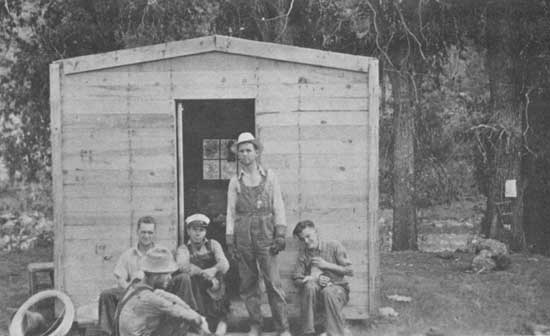
|
|
Figure 71. In camp at O'Neil Landing circa 1939. From left to right:
Harry Ramsey, loaderman; Ray Stout, a truck driver who lived in San
Ysidro; J. F. Cooke, truck driver; John Babich, office manager. (Photo by
Yale Weinstein)
|

|
|
Figure 72. A log dump and several shanties at
O'Neil Landing circa 1939. (Photo by Yale
Weinstein)
|
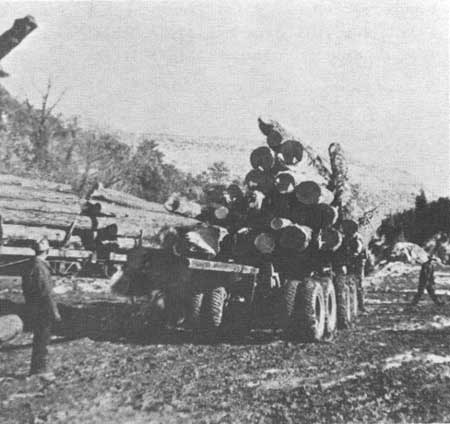
|
|
Figure 73. Dumping a truck load of 16-foot logs
at O'Neil Landing, circa 1937 - 1939.
Superintendent Don Curnutte (left, back to camera) watches. (Photo by
Yale Weinstein)
|
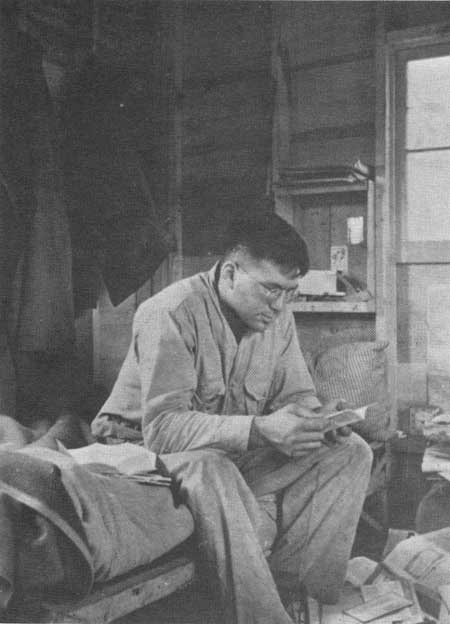
|
|
Figure 74. Joe Goldberg reading in his bunk
shack at O'Neil Landing circa 1939. He graduated from the School of
Forestry of the University of Iowa, where he also played football. He
was later a paratrooper in the Pacific theatre during World War II. Note
the simple construction of the portable building. (Photo by Yale
Weinstein)
|

|
|
Figure 75. Work area at O'Neil Landing circa 1939, showing (left to
right) Bucyrus-Erie Loadmaster, Caterpillar tractor and office
shack. (Photo by Yale Weinstein)
|
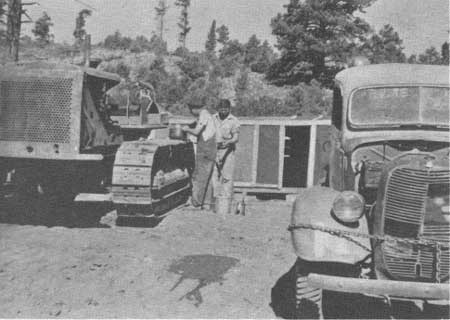
|
|
Figure 76. Working on a Caterpillar tractor at O'Neil
Landing, circa 1939. This open-air workshop was typical of working
conditions in the woods. (Photo by Yale Weinstein)
|
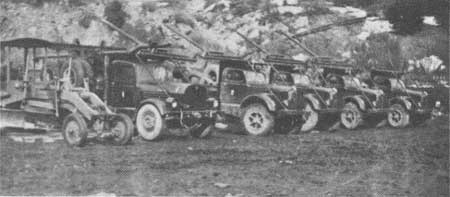
|
|
Figure 77. Log trucks at O'Neil Landing circa 1939.
These vehicles were used for the hauls from logging in the Rio de las
Vacas watershed in the Santa Fe National Forest to O'Neil Landing, and
from the Baca Location to Canyon Landing. From left to right: road
grader, Kenworth diesel truck Number 1, and red-painted White trucks
Numbers 2 through 5. (Photo by Yale Weinstein)
|
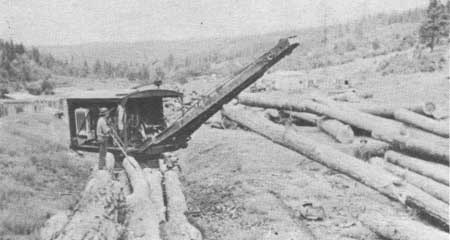
|
|
Figure 78. Loading 32-foot logs at O'Neil Landing with
crane and peavey; summer 1939. (Photo by Yale Weinstein)
|
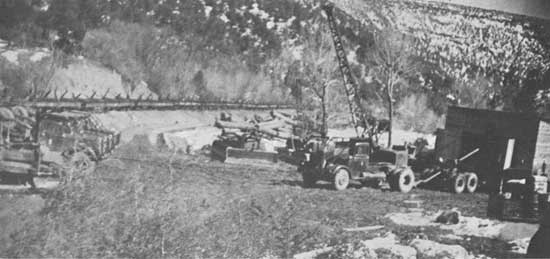
|
|
Figure 79. The truck repair shop area at O'Neil Landing, circa 1939.
Some empty railroad log cars can be seen in the background. (Photo by
Yale Weinstein)
|
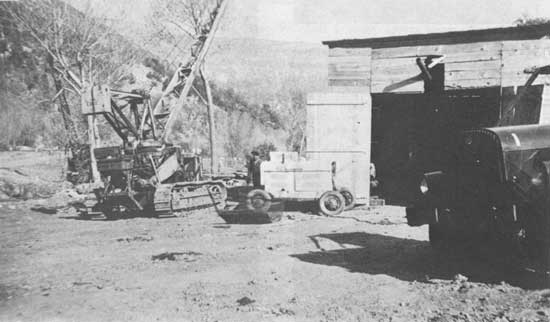
|
|
Figure 80. The truck repair shop at O'Neil landing circa 1939. Equipment
(from left to right) is the Bucyrus-Erie Loadmaster, a Lincoln electric
welder, and the nose of the Kenworth diesel log truck Number 1. (Photo by
Yale Weinstein)
|
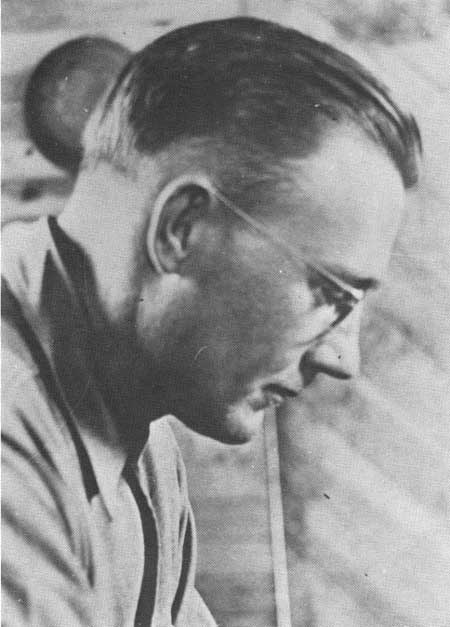
|
|
Figure 81. Don Curnutte, logging superintendent, in a quiet moment at
O'Neil Landing circa 1939. (Photo by Yale Weinstein)
|
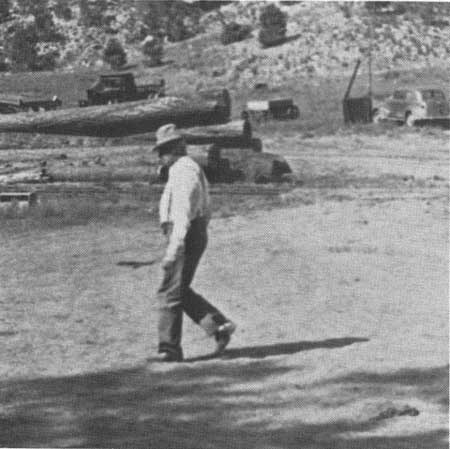
|
|
Figure 82. Walter Giles, the cook at O'Neil Landing, circa 1939. (Photo
by Yale Weinstein)
|
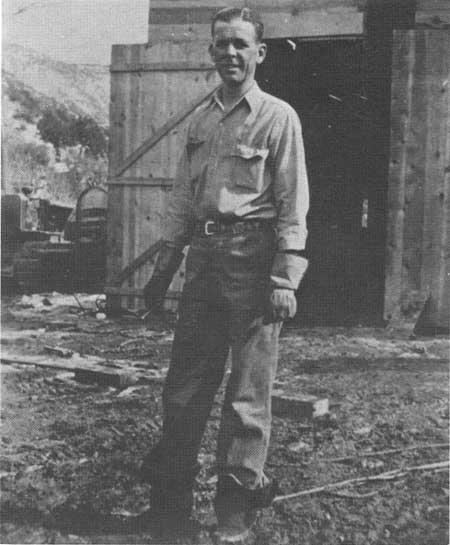
|
|
Figure 83. James F. Cooke at the O'Neil Landing truck shop, circa 1939.
Cooke was a truck driver and known for his fastidious habits in the
rough-and-ready camp, He habitually wore a clean shirt every
day and pulled on heavy gloves to drive, (Photo by Yale Weinstein)
|

|
|
Figure 84. Track maintenance man Melisandro
Martinez with his "speeder" or track motor car,
circa 1937 - 1941. He lived at Canyon, (Photo by
Yale Weinstein)
|

|
|
Figure 85. A conventional railroad motorized section-car posed on
one of the tall trestles along the Rio Guadalupe circa 1932. This image
was made during a family outing rather than a workday. (Photo from the
collection of T. P. Gallagher. Jr.)
|

|
|
Figure 86. Santa Fe Northwestern Railway locomotive Number 101 switching
log cars at the Bernalillo mill circa 1941. (Photo by Charlie Pratt)
|
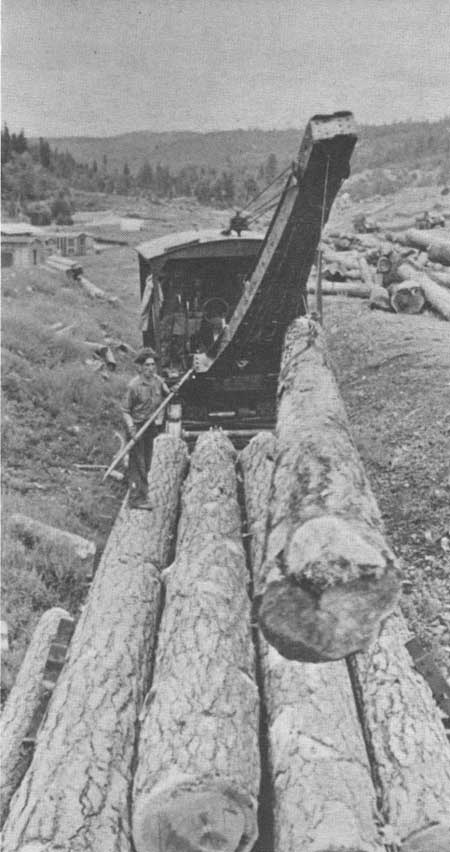
|
|
Figure 87. Log loader and crew at work during the summer of 1939 at
O'Neil Landing. (Photo by Yale Weinstein)
|

|
|
Figure 88. Lumber company employees aboard a railroad speeder, circa
1937 - 1941. From left to right: Boyd Curnutte, mechanic; unknown; Ray
Stout, truck driver; Cone Selby, truck driver; unknown; John Babich;
Will Everett. (Photo by Yale Weinstein)
|
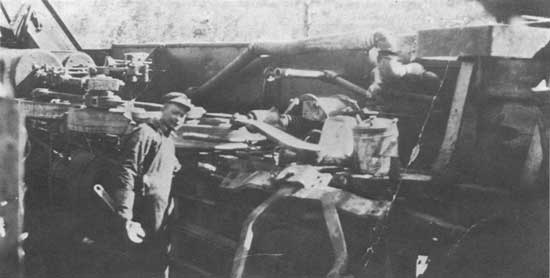
|
|
Figure 89. A mechanic looks over the damage to locomotive Number 101
turned over at a log landing circa 1927. (Photo by A. L. "Red" Gleason
from the Gene Harty family collection)
|
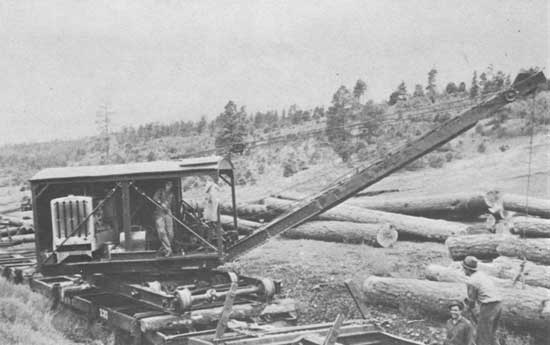
|
|
Figure 90. An American Hoist and Derrick loader at O'Neil Landing in the
summer of 1939. The steam-to-diesel conversion is evident. The steam
boiler, cylinders, and water tank were removed and replaced by a diesel
engine and power take-off mounted on a slide-in frame, Will Everett is
the loaderman. (Photo by Yale Weinstein)
|

|
|
Figure 91. T. P. Gallagher. Jr., as a young man "oiling around" the
running gear of locomotive Number 103. As a youngster growing up in the
lumber industry, Gallagher became familiar with the railroad and its
locomotives. (Photo from the collection of T. P. Gallagher. Jr.)
|
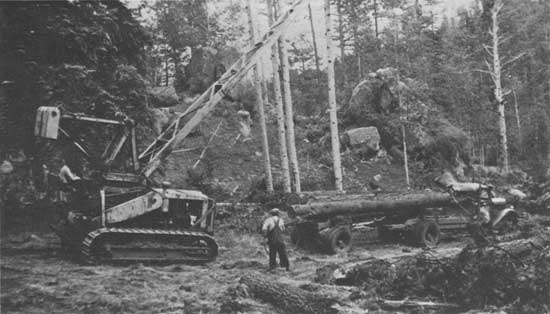
|
|
Figure 92. A Bucyrus-Erie Loadmaster at work in the woods, circa 1937 -
1941. This machine combined the features of a Caterpillar tractor and a
power crane in one unit capable of lifting, moving, and loading logs
efficiently. The boom was capable of rotating as well as lifting,
although the lack of outriggers must have severely limited its capacity
while positioned to the sides. (Photo by Yale Weinstein)
|
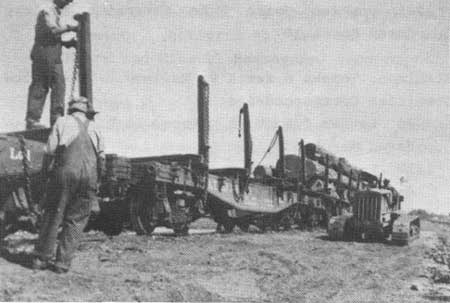
|
|
Figure 93. Unloading log cars at the Bernalillo millpond circa 1941. These cars
were steel AT&SF cars of Class Lg-1 with tall folding stakes. (The
photo is from the Charlie Pratt family album)
|
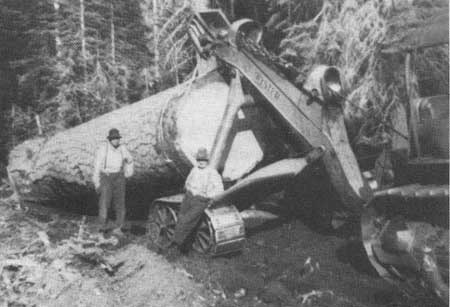
|
|
Figure 94. A Caterpillar tractor skidding a very large log with a Hyster
steel arch, also on tracked wheels, This view, from the C. O. Clark
collection, probably dates from the 1930s.
|
santa_fe/cultres9/appb.htm
Last Updated: 02-Sep-2008
|



























